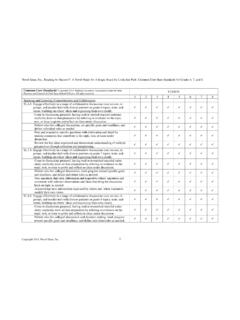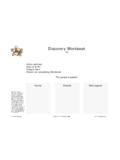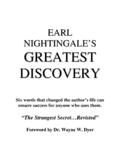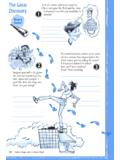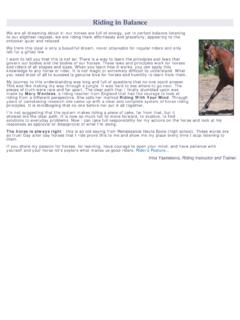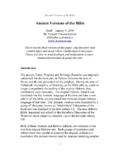Transcription of Bud, Not Buddy: End of Unit Test - A Novel Idea Inc
1 Reading for Success : A Novel Study for Holes by Louis Sachar (Teachers Presentation Book)Copyright 2005, 2015, Novel Ideas, Inc. 125 end of unit test : (Blackline masters for an end of unit test can be found at the end of the Student Workbook. This test may be completed as a guided or independent activity depending on the skill level of your students. If the activities are to be completed as a guided activity, pause after each part to allow students sufficient time to complete the tasks. If the activities are to be completed as an independent activity, have students read all the instructions and then allow sufficient time for the students to complete the test.)
2 Ask students to find Part 1. Call on a student to read the instructions.) The holes you have read about in your Novel study are all man-made. The information passage that follows this introduction tells about other kinds of holes. First, read the questions that are given following the passage. Then read the passage and answer the questions. (Ask students to find Part 2. Call on a student to read the instructions.) Match the vocabulary word with the correct definition. (Ask students to find Part 3.
3 Call on a student to read the instructions.) Circle the letter for the best definition for each vocabulary word. (Ask students to find Part 4. Call on a student to read the instructions.) Decide if each statement is true or false. Write true or false on the line provided. (Ask students to find Part 5. Call on a student to read the instructions.) By the end of the Novel , the main character, Stanley Yelnats, had made a solid friend in Zero. Write a paragraph to tell about at least three experiences they shared that helped to make their friendship grow.
4 You may begin working on the test. END-OF- unit TEST ANSWER KEY Part 1. (5 points each) reasons why people dig holes are tofind oil, to find water, to build houses, tobuild roads, to find metals. (or, to find coal,and gems) cave is a natural, underground hole that isfilled with natural processes that remove rockfrom a secondary cave are erosion materials that allow for the formation ofsolutional caves are limestone, chalk,marble, ice, salt, and are found in solutional and stalagmites might growtogether to form a rock sea cave may be formed by ocean wavespounding against a crack in a rockyshoreline.
5 OR A sea cave may be formedwhen waves pound against soft rocksurrounded by harder rock on the reason why Mammoth Caves inKentucky is so special is that it has thegreatest combined length of passages inthe cave with the largest single room isfound in Borneo, could be called a 2005, 2015, Novel Ideas, Inc. Illegal to Photocopy31 Holes: end of unit test Part 1. Reading for Information: (50 points) The holes you have read about in your Novel study are all dug by people. The information passage that follows this introduction tells about other kinds of holes.
6 First, read the questions that are given following the passage. Then read the passage to answer the questions. Caves are Natural Holes People make lots of holes. People dig holes to build houses or other buildings. They drill holes to search for oil, water, coal, or metals and gems. They use explosives to blast holes in mountains to build roads. All of these holes are made by people. There are other kinds of holes, called caves, that are made by natural forces. A cave is a natural, underground hole that is filled with air.
7 There are two main types of caves. A primary cave is one that is formed at the same time as its surrounding rock. A good example of a primary cave is a lava tube. The more common kind of cave is the secondary cave. A secondary cave is made when underground rock is removed by some kind of natural force or process. The processes that remove rock are solution (so-lue-shun) and erosion (ee-roe-zhun). These processes leave behind a void in the underground rock. Void is another word for hole. Solutional caves are found in soft rock that dissolves slowly in water.
8 As the rock slowly dissolves, huge spaces can be left behind in the surrounding rock. If an entry point can be found, these caves can be explored by humans. The most common kind of solutional cave is found in limestone rock. About 80 percent of the world s caves are found in limestone. Other materials that allow for solutional caves to be formed are chalk, marble, salt, sandstone, and ice. Solutional caves often have beautiful and spectacular features like stalactites and stalagmites. A stalactite is like a rock icicle that forms from rock dissolved in water dripping from the ceiling of a cave.
9 A stalagmite is a cone-shaped pile that forms under the dripping stalactite. Sometimes stalagmites and stalactites join together to form a magnificent rock column. Erosional caves are formed through the scrubbing and washing-away action of rivers, the wind, or the sea. Sea caves are good examples of erosional caves. Ocean waves may pound up against a crack in the shoreline rock and gradually made it larger until it can be entered by people. It may also be that some of the shoreline rock is softer than the rock that surrounds it.
10 The softer rock gets worn away by the waves and a cave is formed. Caves are found all over the world. They may be small or large. The largest known single room in a cave is in Borneo, Malaysia. It is large enough to hold 40 Boeing 747 jet liners! The cave with the greatest combined length of passages is Mammoth Caves in Kentucky. Mammoth Caves has about 340 miles of passages to explore. People who explore caves for fun are called spelunkers (spuh-lunk-ers). It is an odd-sounding name, but it comes from the name given to scientists who study caves.
